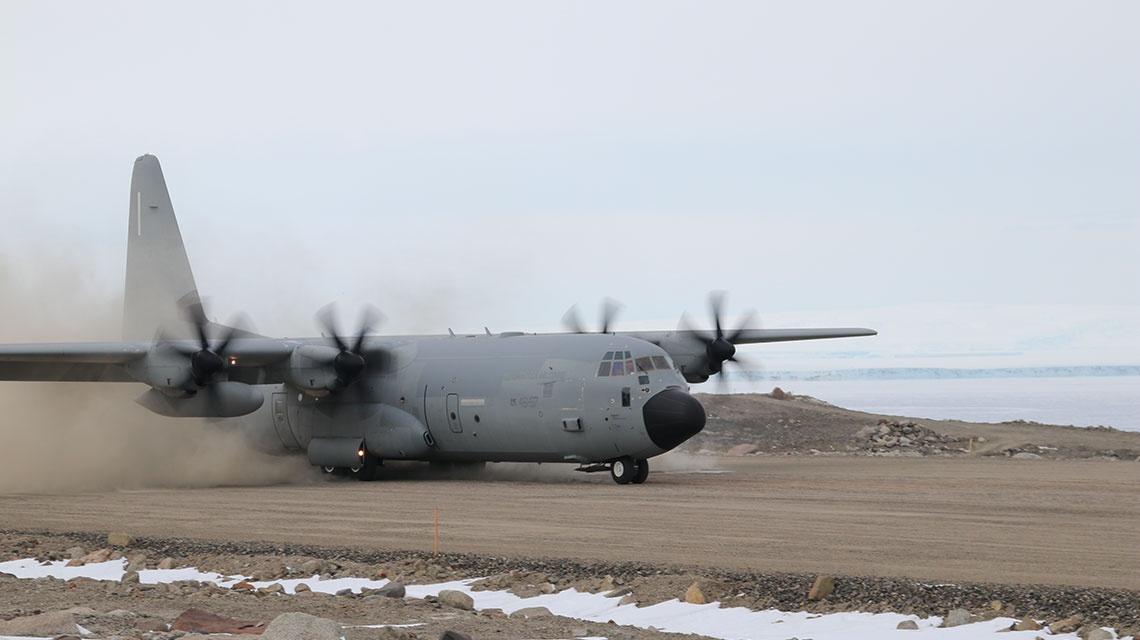Italian National Agency for New Technologies, Energy and Sustainable Economic Development

Antarctica: First technical flight lands on new Italian runway
A C-130J landed on an ice runway designed and built by ENEA and the Italian Air Force, the first in the Antarctic continent to be built on a moraine.
First test landing on the new Antarctic airstrip designed and built by ENEA and the Italian Air Force, in collaboration with the Fire Brigade, thanks to dedicated funding from the Ministry of University and Research. A C-130J of the 46th Air Brigade of the Italian Air Force successfully landed on the semi prepared runway bound to become an international science hub in Antarctica.
The flight carried materials and food to deal with the emergency caused by thinning sea ice, which this year prevented large aircrafts to land on the pack in front of the Italian Mario Zucchelli in Terranova Bay.
60 meters wide and completed for the first 1,700 meters out of the 2,200 envisaged by the project, it’s the first runway to be built on a moraine, using the debris deposits that dominate Boulder Clay, a glacier over 100 meters thick, located 4 km from the Zucchelli station. The airstrip will be fully operational already by next Antarctic expedition.
"This runway will increase reliability, flexibility and safety of logistic operations of the PNRA - National Antarctic Research Programme", explained Elena Campana, head of the ENEA Antarctic Technical Unit, which coordinates logistics planning of the Italian shipments. “It is an important resource – she said – also for the other Antarctic programs operating in the Ross Sea. Both the Antarctic Programs of New Zealand and South Korea have already expressed their strong interest in collaborating to this infrastructure, which will also support the activities of the US Antarctic Program".
“The Air Force had a key role in both designing and building the Boulder Clay runway, also thanks to on-site deployment of numerous earthmoving machines by the Infrastructure Service of the AM Logistics Command. This is a unique project globally, extremely complex due to the severity of the Antarctic environment and the site in which it stands, which required a long preliminary study and monitoring of its structural stability, conducted jointly with ENEA and the PNRA”, explained Lieutenant Colonel Antonello Germinario, Air Force engineer officer involved in the design of the work and geotechnical expert and site manager. “In order to assess the landing and take-off suitability of the various aircraft categories – he said – the runway structural resistance indexes are constantly monitored both by the Geotechnical Laboratory of the 2nd Military Engineering Department A.M. and ENEA".
The airstrip is made up of superimposed layers of material available on site: the foundation is made up of coarse stone material while the upper layers are made of gradually decreasing grain size material, using the Air Convection Embankment (ACE), which favors the convection of air inside the structure, protecting the underlying moraine/glacier system from overheating during the summer.
“Sea ice surface is suitable for air operations, but it’s unreliable over time. First of all, it can only be used for no more than a month at the beginning of the austral summer, before seasonal heating makes it unsuitable for this activity", explained Gianluca Bianchi Fasani of ENEA, technical manager of the work and expedition leader of the 38th Italian Antarctic Expedition.
“This year the prolonged and intense katabatic winds combined with severe sea storms that occurred in the area prevented the ice from reaching the minimum thickness required to set up an airstrip on the pack ice, forcing us to divert air operations to the US base in McMurdo. A gravel track could be the solution also for the future. The flight of the Air Force at Boulder Clay has been a technical test before becoming operational next year", concluded Bianchi Fasani.
“The semi prepared airstrip in Antarctica makes us particularly proud,” pointed out Brigadier General Mario Sciandra, Head of the Infrastructure Service of the Air Force Logistics Command. “This collaboration has allowed to tackle and successfully resolve inexplored issues, allowing our technicians to acquire extraordinary experience contributing to expand their skills in the construction of so-called semi-prepared airstrips in support of the Air Force operativity".
The Italian missions in Antarctica are funded by the Ministry of University and Research as part of the PNRA. ENEA coordinates logistics and the Cnr scientific planning. The 38th Italian expedition to Antarctica started in October and comprises 240 technicians and researchers - including 23 operators and specialists from the Army, Navy, Air Force and Arma dei Carabinieri - engaged in 50 projects mainly concerning atmospheric sciences, geology, paleoclimate, biology, oceanography and astronomy. The Air Force is contributing with a C-130J of the 46ª Air Brigade, with crews trained to operate in extreme climate and environmental conditions.
